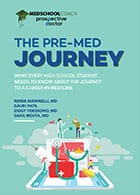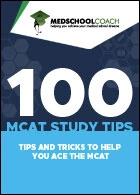
Table of Contents
Because “pre-med” isn’t an actual major at most schools, students in undergraduate studies who want to go to medical school often major in various science programs. Their required science courses often help them when applying for medical school.
However, that doesn’t mean you have to follow the traditional pre-med path to successfully get into medical school.
Does Degree Choice Really Matter?
Many students enter college still contemplating their undergraduate degree. Others send in their college applications from high school with a clear plan — they know they want to be pre-med majors and go to medical school. These students have the advantage of knowing some of the medical school prerequisite courses and exams they’ll need to get there.
Whatever your personal timeline is, you’ll need to meet admissions requirements for medical school, score well on the MCAT, and maintain a decent GPA throughout your undergrad years while taking the required courses that medical school admissions are looking for.
Let’s take a look at what this process might look like for undergraduate students interested in becoming physicians who don’t start out with a pre-med focus.
Traditional Pre-Med Majors
Though “pre-med” is not a major, if you are in traditional science majors like biology, biochemistry, or neuroscience, your course credits may overlap completely with med school requirements. That means you won’t have to take extra courses to pursue your path to medical school.
If you choose a non-science major, you’ll still need to complete the required prerequisite science courses, so you have to plan more strategically. Note that Psychology courses do not count towards your BCPM cumulative average (this is a common misconception).
Non-Traditional Majors
If you’re wondering if you can make your way into medical school by just taking your MCAT and an undergrad degree, the answer is no; you also need a Bachelor’s degree and passing grades in specific science courses to attend medical school.
That being said, many non-traditional pre-med students have majored in English, anthropology, and even art history, and successfully made the pivot – meaning you can, too.
Admissions committees will require prerequisite courses to accept your application to their school of medicine, though. Most often, the prerequisite courses consist of core classes adjacent to the medical field, like biology, physics, chemistry, and mathematics.
As long as you have the prerequisite courses that meet the criteria for the school you’re hoping to apply to, then you’re prepared to move on to preparing to take the MCAT.
Work one-on-one with a Physician Advisor to plan your courses, prep for the MCAT, and build your extracurricular profile.
Expert Tips for Non-Traditional Applicants
You can go to med school with any major. If you decide you want to go to medical school after your sophomore year of college, though, your premed courses and exams may mean you need to take a gap year or spend extra time in undergrad.
Sophomores or juniors who decide they want to attend medical school should go ahead and start taking pre med courses. Talk to your advisor about registering for classes like biochemistry, organic chemistry, physics, general chemistry, and biology.
These required courses are a bit challenging, so we don’t recommend squeezing all of the premed requirements into three semesters. It may sound doable, but getting good enough grades to get into medical school is difficult.
Look at the normal course schedule of a freshman premed student and follow that plan, even if it means extending past your graduation date. You can also look into post-bacc pre-med programs, which are specially designed to help you fulfill medical school prerequisites and build other aspects of your application, like research and letters of recommendation.
Maintaining a good GPA in premed courses is the most important thing. Your GPA is a major component in the admissions process.
Focus on Getting a Strong BCPM GPA
Understanding the courses that you should take as a prospective med student is important, and of all the courses you’ll be taking throughout college, your science courses are the ones that will matter the most for your application to med school.
A recommended BCPM GPA is a 3.5 or higher, while other schools require a 3.7. (Reminder: Your BCPM GPA is the Biology, Chemistry, Physics, and Mathematics cumulative grade point average, while your standard GPA takes into account all your courses.)
Don’t Forget About Letters of Recommendation
While you’re pursuing your pre-med courses, don’t forget to build relationships with your professors so you can secure strong letters of recommendation. LoRs will be an important component of your med school application, and it’s a good idea to be proactive about who you’re going to ask and when.
Most medical school admissions committees require at least three letters of recommendation: two letters from science faculty members and one letter from a non-science faculty member.
If you’re a non-traditional pre-med who’s pursuing a humanities or social science major, you should have no problem obtaining the non-science letter. Just be sure to make plans for the other two science letters.
You can drop by your science professors’ office hours or try to get involved in their research. Whatever you do, just make sure your professors know you when you reach out for a letter.
Pursue Relevant Extracurriculars and Experiences
During an “off-cycle” period between coursework and medical school applications, seek meaningful healthcare-related experiences that will distinguish your application. Admissions committees value unique experiences that help candidates stand out.
Utilize Your Gap Year(s)
Taking a gap year (or even 2-3 gap years) is incredibly common for many students pursuing medical school. Some of the best options for how to spend this time to get more experience and prepare for your med school applications are:
- Work in cutting-edge research laboratories
- Volunteer abroad with organizations
- Gain experience at addiction treatment facilities
- Retake poorly-scored courses and/or take prerequisites during a post-bacc
- Work as a full-time Emergency Medical Technician (EMT)
Read More: Should You Take a Gap Year Before Medical School?
Meet Expected Experience Targets
Non-science majors must still complete all prerequisite science courses and get extracurricular hours (and sometimes research hours) to be competitive medical school applicants. Plan your academic schedule and extracurricular activities strategically to meet these requirements.
- Physician shadowing: 50-100 hours, across 5+ different physicians
- Volunteering: 300+ hours
- Clinical experience: 300+ hours
- Leadership roles: 100+ hours
- Research: 400+ hours
Complete a Post-Bacc Program
The average medical student takes at least one year off before starting medical school, and these experiences are what make your application memorable. If you decide during your senior year that you want to apply to medical school, you’ll almost certainly need to complete a post-baccalaureate program.
Many schools offer these with 1-2 years of coursework. Some hold classes just for post-baccalaureate students, while other universities mix post-baccalaureate students into undergraduate pre-med courses.
Here, you’ll find career-changers of all ages, along with other students who simply didn’t realize they wanted to become a doctor until late in college.
The one thing they all have in common is that they are fully committed to becoming a doctor, especially if they’ve left a stable job and salary to make this leap into medicine.
It’s crucial to earn a high GPA and get a little bit of research or volunteer experience in a medically related field. However, your previous life or job experience will make your application interesting, too.
Some of the post-bacc premed programs have linkage agreements with certain medical schools or their own medical school.
Linkage agreements allow you to select one medical school. If accepted, you can enter immediately after finishing your post-baccalaureate courses and MCAT without having to wait another application cycle.
In today’s tough application pool, this type of agreement is often a safer way to ensure you get into medical school, especially if you hope to study in a specific geographic area.
Read Next: Applying to Med School as a Non-Traditional Applicant
Consider an SMP With Linkage to Medical School
You could also consider taking a Special Masters Program with linkage to a specific med school. These programs can be helpful for those who:
- Have a GPA between 2.7-3.5.
- Have an MCAT score that is between 498-506.
- Don’t have a lot of science credits.
- Haven’t attended a premedical program in a long time.
- Have limited clinical hours, research experience, or shadowing opportunities.
- Desire to go to a linked college of medicine.
Aim for a High MCAT Score
Every student trying to get into a DO or MD program knows about the MCAT exam. The Medical College Admission Test plays a significant role in your chances of catching the attention of the med school admissions committees.
The MCAT covers four major sections:
- Section 1: Chemical and Physical Foundations of Biological Systems (Chem/Phys) — This 95-minute section covers general chemistry, physics, biochemistry, organic chemistry, and biology.
- Section 2: Critical Analysis and Reasoning Skills (CARS) — This 90-minute passage-based section of the MCAT does not test science concepts. Instead, the CARS section requires students to read passages covering various humanities and social studies topics and then answer questions that test pre-medical students’ critical thinking, problem-solving, and understanding of each passage.
- Section 3: Biological and Biochemical Foundations of Living Systems (Bio/Biochem) — This 95-minute section covers primarily biology and biochemistry, with a bit of general and organic chemistry thrown in.
- Section 4: Psychological, Social, and Biological Foundations of Behavior (Psych/Soc) – This 95-minute section covers psychology, sociology, and a bit of biology.
According to the AAMC, the average MCAT score for the 2024 AMCAS application cycle was 500.7. However, the average score for matriculants for DO and MD programs is higher (503 and 512, respectively).
You’ll want to study as much as you can to get a high MCAT score, especially if you are a non-traditional student. This will be vital to your application process for med school admissions. Consider enrolling in MCAT prep courses or finding a tutor who knows the rigors of this exam.
Whether it’s your first or second time taking the MCAT, our expert tutors provide one-on-one guidance and personalized prep tailored to meet your unique goals, needs, and target score.
FAQs
Increase Your Chances of Acceptance With MedSchoolCoach
Whether you took a short detour into another career or haven’t completed your science courses yet, it’s not too late to pursue medicine.
At MedSchoolCoach, we help non-traditional applicants turn unique experiences into strengths, get on the right track, and strategically plan out the prerequisite coursework required for med school acceptance.
Schedule a free 15-minute consultation with our enrollment team today to see how we can help you boost your chances of acceptance for medical school – even if you don’t have a traditional “pre-med” major.

Sahil Mehta MD
Dr. Mehta is the founder of MedSchoolCoach and has guided thousands of successful medical school applicants. He is also a practicing physician in Boston where he specializes in vascular and interventional radiology.





